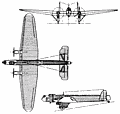|
| Twin 447kW Rolls-Royce Kestrel Vl-engined cantilever low-wing monoplane heavy night bomber, 14 of which were operated by the RAF from 1937 until just before the outbreak of World War II.
 | A three-view drawing (676 x 642) |
| CREW | 5 |
| ENGINE | 2 x Rolls-Royce Kestrel IV, 440kW |
| WEIGHTS |
| Take-off weight | 9072 kg | 20000 lb |
| Empty weight | 5774 kg | 12730 lb |
| DIMENSIONS |
| Wingspan | 31.0 m | 102 ft 8 in |
| Length | 18.5 m | 61 ft 8 in |
| Height | 5.6 m | 18 ft 4 in |
| Wing area | 110.0 m2 | 1184.03 sq ft |
| PERFORMANCE |
| Max. speed | 249 km/h | 155 mph |
| Cruise speed | 215 km/h | 134 mph |
| Ceiling | 6500 m | 21350 ft |
| Range w/max.fuel | 2200 km | 1367 miles |
| Range w/max payload | 1900 km | 1181 miles |
| ARMAMENT | 3 machine-guns, 1100kg of bombs |
| Jon Hayter, e-mail, 06.06.2013 00:53 There was a proposal for an updated Hendon with retractable
undercarriage and more powerful engines but by that point the
Whitley, Hampton and Wellington were in the works, the Stirling well along so there wasn't much point in further
developing an obsolete design. As far as I am aware there is no connection between the Hendon design and that of the
Manchester /Lancaster other than both serving in the same air force and both utilising Rolls Royce engines. reply | | Roger Markman, e-mail, 02.05.2012 20:39 There was a proposal for a four engined Hendon known as the Hendon Mark V. This does indeed look amazingly like the Lancaster!
I have long thought that Roy Chadwick, the designer of the Lancaster,must have been inspired by the Hendon. The factory where they were being built was only a few miles from Avros!
Does anyone have any information on the Hendon MkV? reply |
| Barry, 14.03.2011 17:54 The Hendon flew with No38 Squadron and a detachment forming the nucleus of 115 Squadron. It was withdrawn from use in January 1939 when some of the aircraft were barely 2 years old. You see that even some 70 years on our civil servants and politicians are no different now to what they were then. reply | | Barry, 14.03.2011 17:52 The Hendon flew with No38 Squadron and a detachment forming the nucleus of 115 Squadron. It was withdrawn from use in Januaery 1939 when some of the aircraft were barely 2 years old. You see that even now some 70 years on our civil servants and politicians are no different now to what they were then. reply | |
| | Geoff Trenholme, e-mail, 25.06.2010 23:19 Firstly the span in feet is incorrect 31.0 metres is not 102'8", but 101'9" anyway pedantics aside -
This was designed to a 1927 specification and there were handling problems because it was a monoplane, all other submissions being biplanes that the RAF and ministry understood.
The performance was way ahead of the biplane design chosen for volume production (H.P. Heyford)
The later Heyfords offered maximum range 920 miles, the Hendon 1360 miles. Maximum Speed Heyford I 138 MPH, the improved II & III 154 mph, The Hendon 155 mph but only ever in Mk.1 as no further development.
Max altitude Heyford 21,000 Ft, Hendon 21,400 Ft.
So although a better aircraft it's monoplane design had handling that was not acceptable to an airforce used to biplanes. So another advanced design was delayed due to official ignorance until it had become obsolete. A similar story to the Westland Whirlwind Fighter - a mosquito before it's time !! Even the Mosquito was a private venture as the ministry were not interested ... until !!! reply | | Sean Rumley, e-mail, 29.03.2010 21:24 While we know that there was a problem in the thirties with aero engine manufacturers trying to up the power of their engines to match the ever more exotic aircraft designs, I must admit that I have never seen a more seemingly(and actually!)underpowered aeroplane in my life...how on earth did it even get off the ground!? reply | | John Hyde-Smith, e-mail, 12.09.2007 22:50 The Fairey Hendon has an extraordinary history. Development to the point where it could be considered for squadron service took more than 6 years, so that by the time it did enter service (end 1936) it was already hopelessly outdated and obsolete. There were clearly very serious problems with it, a major one must have been getting off the ground! This aeroplane was only slightly smaller than the Avro Lancaster but it had only two engines of 600 h.p. each, in other words the Lancaster had more power in one of its four engines than the Hendon had in total. Would anyone have tried a take-off with a Lancaster with only one engine running? I think not, and yet in essence this was what a take-off with the Hendon involved. No wonder the R.A.F. operated only 14 of them for no more than 2 years. reply | | Jakub Marszalkiewicz, e-mail, 10.11.2006 06:11 I think that it would be the basement of designing of Avro Lancastrian - shape was very similar. reply |
|
Do you have any comments?
|
| 
COMPANY
PROFILE
All the World's Rotorcraft
|








Hi - Just posted info on 4 engined development of the Fairey Hendon. This does not allow me to post a link directly but if you google "superhendon" you should find it.
reply